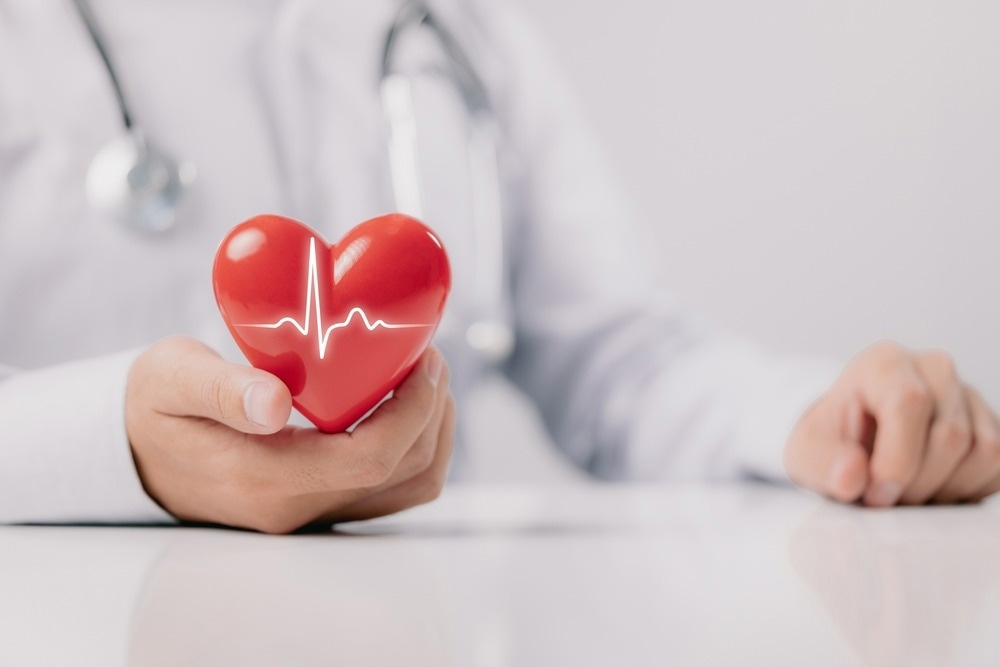Gene therapy shows promise for arrhythmogenic cardiomyopathy
In a recent study published in Nature Cardiovascular Research, a group of researchers evaluated the effectiveness of adeno-associated virus (AAV)-mediated Plakophilin 2 (PKP2) delivery in treating arrhythmogenic cardiomyopathy (ACM).

Background
ACM is a genetic cardiac disease, prevalent in 1:2,000 to 1:5,000 individuals, often diagnosed late due to its complex and variable nature. Initial symptoms are subtle, but the disease can progress to severe ventricular arrhythmias and heart failure, sometimes necessitating a heart transplant.
About half of ACM cases are linked to mutations in desmosomal genes like PKP2, which play a crucial role in heart muscle cell connectivity. PKP2 mutations, especially in their truncating forms, disrupt desmosomal integrity, leading to heart muscle dysfunction and ACM progression.
Despite advancements in understanding ACM's molecular basis, effective treatments are lacking, with current options focusing on symptom management. Further research is needed to develop effective therapies for ACM and to explore the full potential of PKP2 restoration in reversing disease progression and improving cardiac function.
About the study
In the present study, human induced pluripotent stem (iPS) cell lines carrying PKP2 c.2013delC and PKP2 c.1849C>TiPS mutations, sourced from the University of California San Diego and Stanford Cardiovascular Institute, were cultured.
These cells were grown on Geltrex-coated wells, routinely fed with Essential 8 Medium, and passaged upon reaching 80-100% confluency using TrypLE Express Enzyme. For cardiomyocyte (CM) differentiation, the cells, at 80-90% confluency, were treated with RPMI-1640 Medium containing human recombinant albumin, CHIR99021, and L-ascorbic acid 2-phosphate, followed by IWP2 addition on day 2.
From day 4, the medium was consistently supplemented with albumin and L-ascorbic acid 2-phosphate, and after day 8, maintained in Roswell Park Memorial Institute (RPMI)-1640 with B-27 Supplement.
To assess CM purity, 1 million 15-day-old iPS-cell-derived CMs underwent a series of centrifugation and washing steps, followed by fixation in ethanol and permeabilization. They were then stained with anti-Cardiac Troponin T antibody and Alexa 488-anti-rabbit antibody analyzed by fluorescence-activated cell sorting.
Automated patch clamp experiments on these CMs were conducted using the SyncroPatch 384 device. The protocol included the use of a voltage step protocol and specific pipette and bath solutions for recording sodium currents. Engineered human myocardium (EHM) was generated by mixing iPS-cell-derived CMs with human foreskin fibroblasts in a collagen matrix, casting them into wells, and incubating them. The medium was initially supplemented with Transforming Growth Factor Beta 1 (TGFβ1), followed by regular EHM medium.
The contraction of EHM was analyzed using video-optic recordings, measuring parameters like contraction amplitude, velocity, and relaxation times. Quantitative real-time polymerase chain reaction (PCR) was performed on iPS-cell-derived CMs to study gene expression. Mice used in the study were maintained on a C57B/6J background, with animal experiments approved by relevant regulatory bodies. Echocardiographic analysis was performed under anesthesia, measuring various cardiac parameters.
For histology and immunohistochemistry, cardiac tissues were fixed, embedded, and sectioned. Tissue sections were subjected to antigen retrieval, blocking, and incubation with primary and secondary antibodies, followed by imaging. Western blot analysis was carried out on protein extracts from both iPS-cell-derived CMs and mouse ventricular tissues, using specific antibodies for detection.
AAV vectors encoding human and murine PKP2 or empty vectors were used for in vitro and in vivo studies. For in vitro studies, hiPS-cell-derived CMs were infected with AAV6, while in vivo, AAV9-ctr and AAV9–PKP2 were injected into mice either intraperitoneally in pups or intravenously in adults. Statistical analysis involved Student’s t-tests, Analysis of Variance (ANOVA), and post-hoc testing as appropriate, using GraphPad Prism software.
Study results
The present research was motivated by data from the Dutch ACM registry, which indicated that a substantial portion of ACM patients possess pathogenic PKP2 variants. To investigate the effects of PKP2 restoration, researchers employed a patient-derived iPS cell line with a PKP2 mutation. Using an AAV vector, they successfully restored PKP2 protein levels in these cells. This intervention not only improved PKP2 levels but also positively influenced other desmosomal proteins crucial for cell-cell adhesion in the heart.
The study further explored the effects of PKP2 restoration on CMs electrical properties, particularly focusing on sodium conduction. This aspect is critical since irregularities in ion channels contribute to the arrhythmic nature of ACM. The researchers found that PKP2 restoration in mutant CMs normalized sodium conduction, potentially addressing the arrhythmic substrate characteristic of ACM.
Building on these cellular findings, the research extended to three-dimensional EHM composed of a mix of iPS-cell-derived CMs and human foreskin fibroblasts. This model allowed for a more in-depth examination of PKP2's role in cardiac tissue. The mutant EHMs exhibited impaired contractile function, a hallmark of ACM. However, upon restoring PKP2 in these tissues, there was a noticeable improvement in contractility and a re-establishment of more organized intercellular junctions.
To translate these findings to a more clinically relevant scenario, the team utilized a murine ACM model with a human-equivalent PKP2 mutation. They administered an AAV vector carrying the wild-type PKP2 gene to these mice. The treatment successfully restored PKP2 levels in the heart tissue and led to a reconstitution of both desmosomal and adherens junction proteins. These changes at the molecular level translated into improved cardiac function in the mice.
In a crucial long-term study, the researchers administered PKP2 to mutant and wild-type mice, observing the outcomes over a 12-month period. This long-term administration of PKP2 resulted in a significant recovery of cardiac function in mutant mice without inducing adverse effects in wild-type mice or other organs. The mice exhibited improved electrical and mechanical heart functions, suggesting that PKP2 restoration could indeed reverse some of the key aspects of ACM.
- Kyriakopoulou, E., Versteeg, D., de Ruiter, H. et al. Therapeutic efficacy of AAV-mediated restoration of PKP2 in arrhythmogenic cardiomyopathy. Nat Cardiovasc Res 2, 1262–1276 (2023). doi: https://doi.org/10.1038/s44161-023-00378-9 https://www.nature.com/articles/s44161-023-00378-9
Posted in: Medical Research News | Medical Condition News | Disease/Infection News
Tags: Albumin, Antibodies, Antibody, Antigen, Ascorbic Acid, Cardiomyopathy, Cell, Cell Adhesion, Cell Line, Cell Sorting, Collagen, Efficacy, Enzyme, Ethanol, Fluorescence, Gene, Gene Expression, Gene Therapy, Genes, Genetic, Growth Factor, Heart, Heart Failure, Histology, Imaging, Immunohistochemistry, in vitro, in vivo, Ion, Muscle, Mutation, Polymerase, Polymerase Chain Reaction, Protein, Research, Software, Transplant, Troponin, Virus, Western Blot

Written by
Vijay Kumar Malesu
Vijay holds a Ph.D. in Biotechnology and possesses a deep passion for microbiology. His academic journey has allowed him to delve deeper into understanding the intricate world of microorganisms. Through his research and studies, he has gained expertise in various aspects of microbiology, which includes microbial genetics, microbial physiology, and microbial ecology. Vijay has six years of scientific research experience at renowned research institutes such as the Indian Council for Agricultural Research and KIIT University. He has worked on diverse projects in microbiology, biopolymers, and drug delivery. His contributions to these areas have provided him with a comprehensive understanding of the subject matter and the ability to tackle complex research challenges.